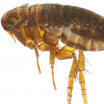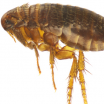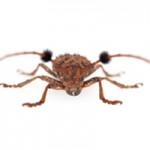The most common domestic flea is the cat flea. The flea has four stages in their life cycle; egg, larvae, pupa and adult. The female can lay more than 400 eggs during their life span which is only 1- 4 weeks. The eggs are laid on the host where they fall off to hatch in the environment. It is required that a female has a fresh blood meal in order to produce eggs and adult fleas are the only stage in the life cycle that live on pets. Adults range between 1 – 3 mm in length and are reddish-brown to black. Their powerful hind legs are well adapted for jumping and running through hair and feathers. They prefer to develop in areas protected from rain fall, irrigation and sunlight.
It has been recorded that fleas have existed for at least 55 million years and since they have been discovered inside of ancient amber it is believed that they thrived off of tree sap and decaying plants. It wasn’t until later that they started to feed on blood of specific kinds of warm blooded creatures like birds, dogs, cats and even humans.
There are over 2000 different types of fleas recorded in which only 1 species of flea lives off the blood of humans. This species of flea is called the Pulex Irritans and usually survives in the human hair. There is another species of flea that uses human hair as a source of travelling until they find a warm blooded creature that is more to their liking. You should not believe that each flea species would restrict its territory within the preferred warm blooded creatures. The human flea particularly does not discriminate against other species, it just loves blood and would feast on dogs, cats, monkeys and other rodents.
Fleas are capable of transmitting plague and murine typhus to humans but reports are rare. Bites often cause itching.





